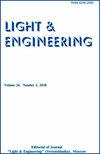Holographic Optical Elements: Advantages and Disadvantages for Efficient Lighting, Sun Protection, and Photovoltaic Power Supply of Buildings
IF 0.3
4区 工程技术
Q4 ENGINEERING, ELECTRICAL & ELECTRONIC
引用次数: 0
Abstract
The research of holographic optical elements (HOE) was carried out very intensively in the 1980s and 1990s. They provided great advantages in high-efficiency natural light, while at the same time providing effective sun protection and did not disturb the free view from the windows. The light-directing qualities of these devices made it possible to concentrate direct and scattered solar energy on photovoltaic batteries and solar collectors for hot water supply and solar heating. However, in recent years, research in this area has become less and less frequent without any explanation. The analysis of the research carried out in the framework of one of the latest projects carried out on behalf of the European Commission under the program “Energy, Environment, and Sustainable Development” (EU Contract Number: ENK6-CT‑2000–00327) with the participation of nine research organizations, higher schools, and universities is presented. The role of each of the participants in this interdisciplinary project was to attract experienced researchers in various fields of science and use their knowledge to obtain an objective result.全息光学元件:建筑高效照明、防晒和光伏供电的优缺点
全息光学元件(HOE)的研究在20世纪80年代和90年代进行得非常密集。它们在高效自然光方面提供了很大的优势,同时提供了有效的防晒,并且不会干扰窗户的自由视野。这些装置的导光特性使得可以将直接和分散的太阳能集中在光伏电池和太阳能收集器上,用于热水供应和太阳能加热。然而,近年来,这方面的研究越来越少,没有任何解释。本文介绍了代表欧盟委员会在“能源、环境和可持续发展”计划(欧盟合同编号:ENK6-CT‑2000-00327)下开展的一个最新项目框架内进行的研究分析,该项目有9个研究机构、高等学校和大学参与。在这个跨学科项目中,每个参与者的作用是吸引各个科学领域经验丰富的研究人员,并利用他们的知识获得客观的结果。
本文章由计算机程序翻译,如有差异,请以英文原文为准。
求助全文
约1分钟内获得全文
求助全文
来源期刊

Light & Engineering
ENGINEERING, ELECTRICAL & ELECTRONIC-OPTICS
CiteScore
1.00
自引率
50.00%
发文量
0
审稿时长
1 months
期刊介绍:
Our magazine
develops comprehensive communication within the lighting community, providing opportunities for discussion and free expression of opinions of specialists of different profiles;
contributes to the convergence of science and engineering practice, the search for opportunities for the application of research results in lighting and technological applications of light;
keeps the scientific community up to date with the latest advances in the theory of the light field, providing readers with operational professional information;
initiates international cooperation, promotes and distributes the results of Russian authors in the international professional community;
provides equal opportunities for authors from different regions of Russia and other countries.
The journal publishes articles in the following areas:
visual and non-visual effects of radiation on humans;
light field theory;
photometry and colorimetry;
sources of light;
ballasts;
light devices, their design and production technology;
lighting and irradiation installation;
light signaling;
methods of mathematical modeling of light devices and installations;
problems of energy saving in lighting, installation and operation of lighting installations;
modern production technologies of lighting products for lighting control systems;
innovative design solutions;
innovations in lighting and lighting design;
the study of the effect on plants and animals, problems of using light in medicine;
problems of disinfection of premises, water and smell elimination with the help of technology of UV radiation using;
problems of light in the ocean and space.
 求助内容:
求助内容: 应助结果提醒方式:
应助结果提醒方式:


